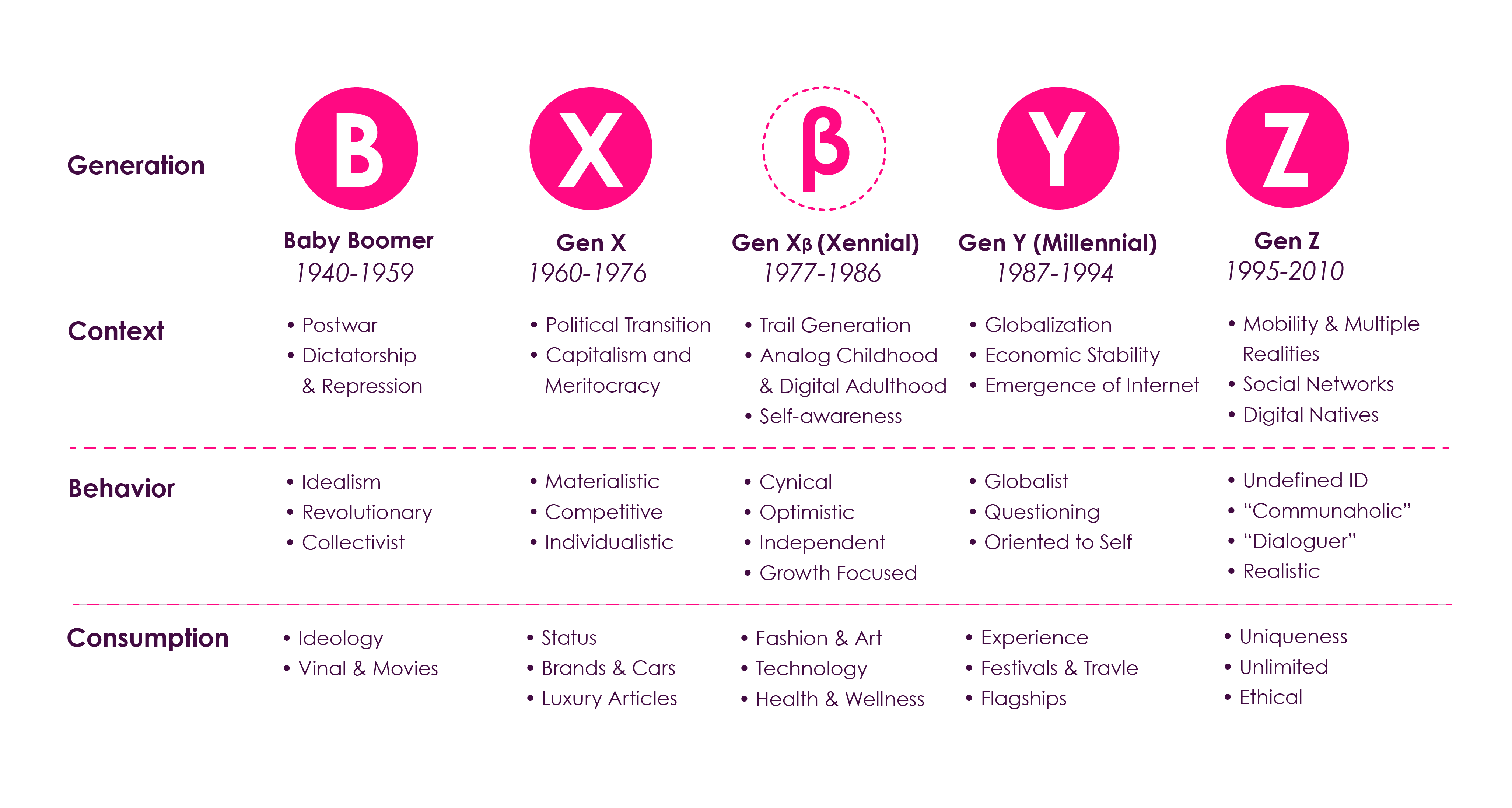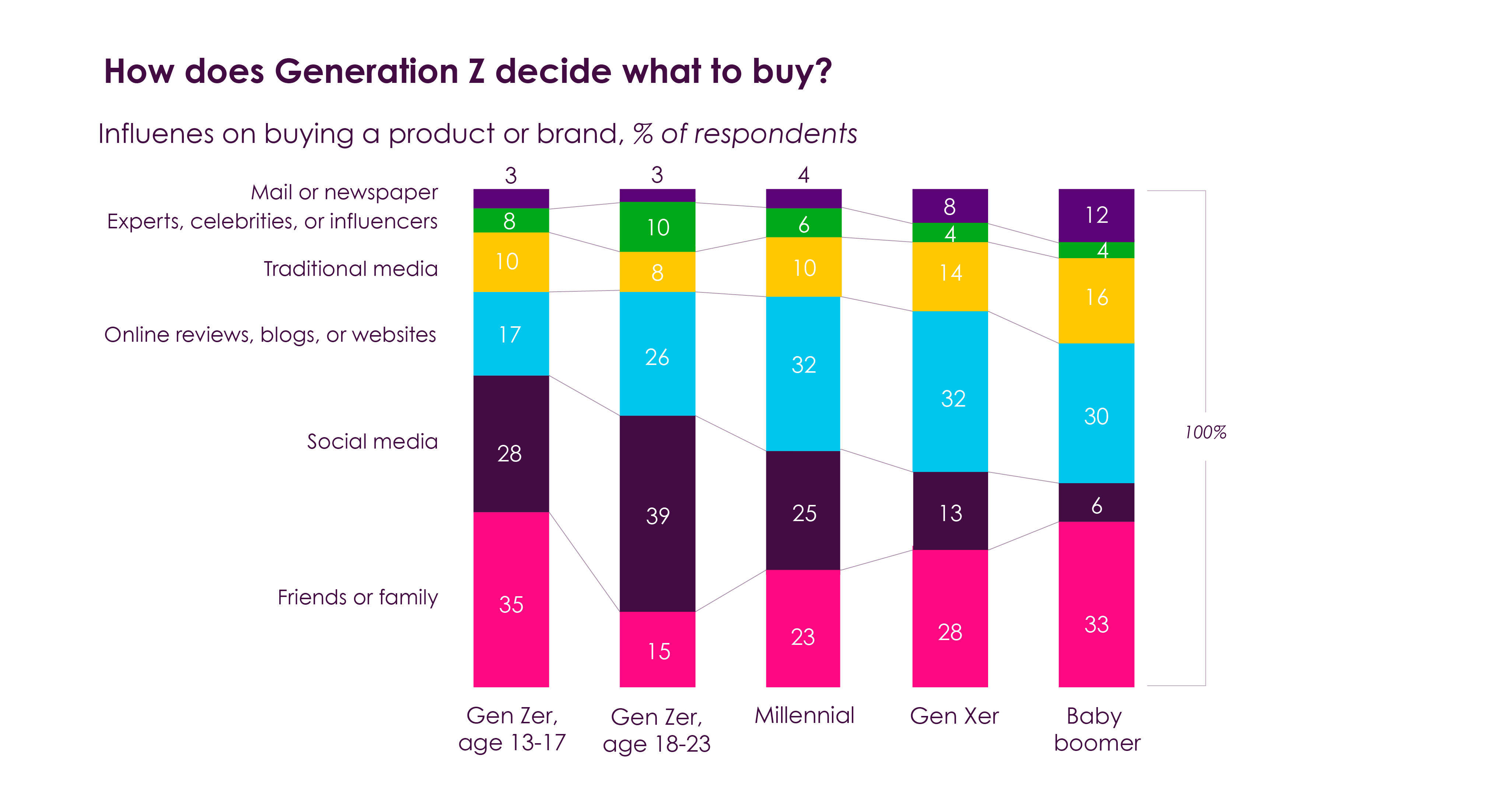You may have heard the terms “Generation Z” and “Millennials” as a way to describe a certain age group, however, the terms are also being used to describe a certain trend, be it in the change in spending habits or behaviours. As e-commerce continues to mature and brick-and-mortar stores are repositioning themselves, finding creative ways to remain relevant, Gen Z is ushering in a new era of shopping for the world of retail.
Although Millennials and baby boomers remain vital to retail, it is interesting to note how this younger age group, who have never known life without the internet, streaming services, apps or shopping online, are spending their money. After all, they are the future of shoppers and currently account for 20% of the market in the US, valued at $144 billion. More importantly, teenagers influence their parents to spend more than $600 billion per year globally.
As we delve into the unique differences between Gen Z and Millennial spending habits; and whether influencer marketing and the concept of instant gratification is still relevant, we highlight a number of interesting facts in buying choices retailers should take onboard for the future of retail.
Gen Z vs Millennial spending habits
Specifically, Gen Z refers to the age group that was born in the late 1990’s and up to 2010. Today, adult Gen Zers should be between the ages of 18 - 24. Millennials, on the other hand, are people born roughly between 1986 - 1996. They should be between 26 - 35 years old in 2022. Although there aren’t that many years between the two age classifications, there are significant differences in the way they shop, make decisions and what they value. If retailers, both online and offline, are wanting to attract and retain this new era of shoppers, they’d be smart to see what makes them tick when it comes to spending.
Omnichannel shoppers
Despite growing up with online shopping as the norm, a McKinsey & Company study that surveyed 10,000 consumers across multiple age groups and 25 product categories found that Gen Z are in fact fans of omnichannel shopping; instead of strictly online-only. Gen Z shoppers enjoy the experience of going to physical stores as well as using their apps to make quick purchases or enjoying the ease of same-day delivery. This is good news for retailers who have an omnichannel strategy, but for those who are solely online, they will need to incentivise shopping online over the tactile and sometimes visceral experience that brick-and-mortar stores offer Gen Zers.
Talk to one of our consultants about dynamic pricing.

Brand authenticity and identity
It is more important for Gen Zers than Millennials to shop from brands or retailers that have a strong brand identity. It is also more valuable for Gen Zers to spend money on brands that value authenticity.
This comes from a desire to stand out instead of fitting in and we see this in their choice to choose brands who focus on issues like sustainability or anti-racism instead of luxury or coolness. According to a report from First Sight, 73% of Gen Zers are happy to pay an extra 10% on an item if they know it is sustainable while for Millennials, brand names have shown to be more important than values. Sporting a jacket from Levi’s Jeans or gym apparel from Lululemon is a large motivating factor for Millennial spending choices, regardless of how the product is manufactured.
This year, McKinsey did an extensive Gen Z survey to find out who they really are and how it affects companies. Below, we see how the various generations are defined and how that definition affects their consumption.
Gen Z’s core behaviours are:

Influencers are becoming less influential
Only 10% of adult Gen Zers (aged 18 - 23) allow influencers or celebrities to inspire or sway their buying choices and although social media is still a large determining factor, 39% to be exact, it is less about a blogger or influencer posting about outfits and products and more about a brand using their social media accounts to engage with users. For example, a brand like Adidas or Fenty Skincare will reach and influence Gen Z more by creating engaging and meaningful content with their own social media pages than handing off an item or product to an influencer to include in an Instagram post. Influencers impact Millennials even less, at only 6%, and their largest motivators at 32% are online reviews, websites and blogs.

Small businesses over global corporations
Afterpay, a fin-tech service in the US that allows you to buy now and pay later, released their findings from January 2020 - July 2021 and found that spending at small businesses increased among Gen Zers by 268%. Millennials still make up the bulk of people who buy from small businesses, but Gen Z takes the cake for the biggest growth rate.
Although thrifting, buying second hand or vintage clothing and furniture was not started by Gen Zers, it is a movement that has been accelerated by them. Because of their age group, most Gen Zers were in primary school during the global financial crash of 2008 and are just finishing high school during Covid-19. Their psyche has been heavily influenced by economic crises, which affects how and where they spend their money.
The age of same-day delivery vs instant gratification
There are two schools of thought surrounding how Gen Z deals with the issue of instant gratification. On the one hand, they are somewhat used to having same-day delivery, or at least next-day delivery as being the norm. On the other hand, Gen Z has shown to take more time with decision-making when it comes to buying within certain categories like clothing, footwear, and skincare products. In addition, it is easier than ever to compare prices for the same product across multiple online stores simultaneously, which is something Gen Zers love to do. According to a Drapers Bespoke study that surveyed 2,000 Gen Z and Millennial shoppers, 51% of Gen Zers find that price comparison is the biggest benefit of online shopping.
However, the same study showed that 45% of Gen Zers picked “waiting for deliveries” as the most annoying thing about online shopping over “unpredictability of fit”. Often referred to as “the last mile”, delivery is likely the most expensive and most important part of the online process for retailers, and with 56% of shoppers not returning to an online store if a delivery took longer than they expected or if there were other delivery issues, the importance of this speaks volumes. This highlights that it is less about instant gratification and more about impulse control and if that impulse is not satisfied within the expected time frame, shoppers may choose to go to the next best option. Gen Zers see delivery as an extension of the retailer or brand they’ve shopped from and include it in their own personal experience.
The future of e-commerce is young, but not unpredictable
A November 2021 report by Bloomberg estimates Gen Z’s disposable income to be approximately €343 billion, which is an estimate that tripled in three years. As mentioned above, Gen Zers have been shaped by economic turmoil at various points in their life, making them a little more susceptible to getting a job as a teenager, getting a part-time job if they already have one, or saving as much of their earnings as they can. It also makes them a little more cautious and thoughtful about who gets their money. Brands like Estee Lauder, Coach and American Express Co. have named Gen Z as prime targets to gain their attention and loyalty, but they will need to look at what Gen Z shoppers value, like and dislike in order to turn them into customers.
However, the difficult part with Gen Z is that it isn’t just one factor that they look to for buying a product - it’s every factor. It is the material used; the country of origin; the ingredients; the makeup of the company’s C-suite; the shipping methods and costs; the very packaging of each delivery; the entire carbon footprint; the way grassroots employees are paid and treated and more.
The connected world of Gen z
It has become the norm to stay abreast with information unlike ever before. Gen Zers, and any other generation for that matter, can find out anything they want to know by simply typing a few words into Google on their smartphones. After all, McKinsey calls this generation “True Gen” to describe one of their core values: A search for truth. Gen Zers want to tell a story with their buying choices, from clothing to skincare, and if brands want to remain relevant to this developing group of consumers, they’d be sure to take a look at how they’re being perceived.




.png?height=766&name=Untitled%20design%20(21).png)